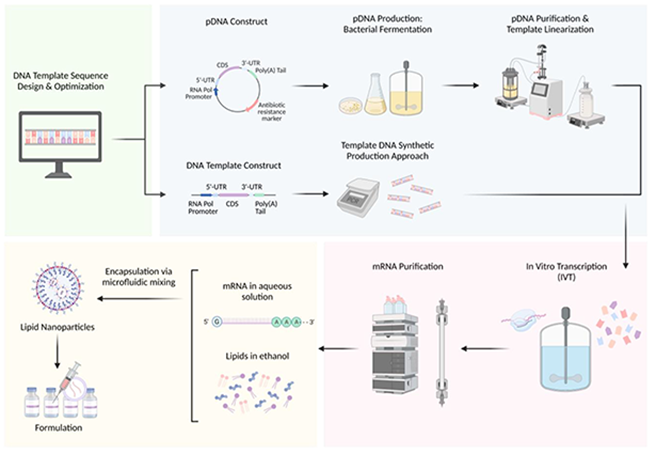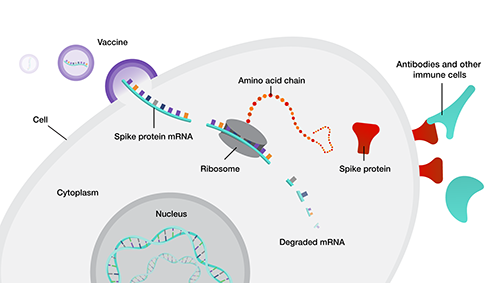mRNA vaccines have revolutionised the fight against infectious diseases, offering rapid production and strong immune responses. But how are they made, and what about safety concerns? Let’s break down the process.
- Localised action, no genome interaction: mRNA remains in the cytoplasm and is degraded after translation; it does not enter the nucleus or integrate into host DNA.
- Effective degradation: Residual plasmid DNA is rapidly degraded by DNases during purification, ensuring safety and purity.
- Transient presence: mRNA and the spike protein are short-lived, ensuring minimal persistence in tissues.
- Validated risk control: Strict adherence to GMP ensures residuals, and impurities are rigorously removed.
- Clinical evidence: Extensive trials and real-world data demonstrate no long-term tissue accumulation or genetic risk.
The mRNA manufacturing process
1. Plasmid DNA template: It starts with a DNA blueprint. A section of DNA containing the instructions for a key protein from the virus is inserted into a circular piece of DNA called a plasmid. This plasmid is grown in bacteria and then purified. In general, the plasmid DNA itself is not inherently harmful to humans. However, if residual DNA were present in large quantities, there are theoretical concerns such as the potential to generate an immune response. Plasmids may be the star of the mRNA vaccine production show, but don't worry – they’re just the backstage crew. By the time the vaccine hits your arm, these guys have already packed up and left the building.
The plasmid used in the Pfizer/BioNTech mRNA vaccine is a circular piece of DNA designed to produce copious amounts of mRNA for the spike protein of SARS-CoV-2. After production, the plasmid is linearised for in vitro transcription into mRNA. It contains the following key structural elements:
- Promoter region: A sequence that initiates transcription of the spike protein.

In the case of the Pfizer/BioNTech vaccine this is derived from a human cytomegalovirus (CMV). This promotor is commonly used in gene expression systems because it drives high levels of gene transcription. - Open reading frame (ORF): The gene encoding the spike protein.
- Poly(A) tail: This ensures the mRNA's stability.
- 5’ cap: Important for recognition by the cell's ribosome.
2. Transcription into mRNA: In the lab, enzymes are used to transcribe (convert) this plasmid DNA into mRNA – the key component of the vaccine. The mRNA carries the instructions for making the viral protein.
3. Purification: After transcription, purification steps remove impurities like enzymes, and any remaining DNA from the plasmid. Residual DNA is typically degraded using DNases, enzymes that break down DNA into tiny fragments. This ensures the final mRNA is of high quality and safe for use. DNase is like nature’s cleanup crew for stray DNA. Think of it like your robot vacuum – it comes in, tidies up all the leftover DNA fragments, and rolls away, leaving your mRNA shiny and ready for prime time.
Image: Youssef et al. 2023. Enabling mRNA therapeutics: Current landscape and challenges in manufacturing.
Available from: https://www.mdpi.com/2218-273X/13/10/1497
Addressing safety concerns: Can DNA or mRNA affect our genes?
One common question is whether the mRNA or any residual DNA can integrate into our own genome, potentially causing harm. Here’s why that’s not a concern:
1. mRNA does not/cannot enter the nucleus: The mRNA in the vaccine stays in the cytoplasm (the outer area of the cell). It’s used by the cell’s machinery to make the viral protein, but it never enters the nucleus, where our DNA is housed. Therefore, there is no possibility for it to integrate into our genes.
2. Residual DNA is degraded: In the extremely rare case that any plasmid DNA remains, it cannot reach the nucleus either. The cytoplasm contains enzymes called DNases, which quickly degrade any foreign DNA that might appear. This ensures that no genetic material persists in the cell.
Image: National Human Genome Research Institute. 2021. Understanding COVID-19 mRNA vaccines.
Available from: https://www.genome.gov/about-genomics/fact-sheets/Understanding-COVID-19-mRNA-Vaccines
Real and perceived risks
Real risks
mRNA degradation: Because mRNA is fragile, it can degrade before reaching the cell if not properly protected by lipid nanoparticles (LNPs), which are used to encapsulate the mRNA. This isn’t a danger to people but can reduce vaccine effectiveness.
Perceived risks
Genetic alteration: As discussed, mRNA and residual DNA cannot alter human DNA. The mRNA is temporary, rapidly broken down after it serves its purpose in helping the immune system recognise the virus.
Think of mRNA as the recipe for a single dish at a dinner party. It tells your body how to whip up a quick protein, and then quietly exits before anyone asks it to stick around for dessert (or mess with your DNA).
The mRNA vaccines manufacturing process contributes to vaccine safety
The production process for mRNA vaccines is highly controlled, using Good Manufacturing Practices (GMP) to minimise contaminants and ensure safety. Each batch undergoes rigorous testing for impurities such as residual DNA, endotoxins, and potential allergens.
NOTE: It is important that quality control and regular monitoring is done by experts using validated tests. When people without the proper expertise try to perform and interpret lab tests relevant to this topic, it's a bit like handing a violin to someone who thinks they can play just because they've heard Mozart – what results is more screech than symphony. In the same way, scientific testing requires precision, context, and deep knowledge, not just a do-it-yourself (DIY) spirit. Without the right skills, they're more likely to generate noise as they are to uncover meaningful results. Science isn’t just a guessing game – it’s a discipline for a reason! Each batch of vaccine is tested for purity and potency.
Some claims and fact checks
Despite the fragile biological nature of mRNA there have been claims that it hangs around and infiltrates places it should not be. Here are some common claims regarding mRNA vaccines, along with fact-checks:
Claims about being found in various tissues
Claim 1: "mRNA vaccines accumulate in organs like the liver, spleen, and ovaries."
Fact-check:
![]() Nope. This claim is often based on misinterpretation of biodistribution studies in animals, where small amounts of lipid nanoparticles (LNPs) were detected in various organs. However, the mRNA itself is quickly broken down and does not persist. Human studies have not shown harmful accumulation in these organs.
Nope. This claim is often based on misinterpretation of biodistribution studies in animals, where small amounts of lipid nanoparticles (LNPs) were detected in various organs. However, the mRNA itself is quickly broken down and does not persist. Human studies have not shown harmful accumulation in these organs.
Claim 2: "mRNA from vaccines stays in the body for long periods."
Fact-check:
![]() Nope. mRNA is inherently unstable and is rapidly degraded by enzymes in the body. Typically, it is broken down within hours to days. The body has enzymes that break it down rapidly. The spike protein it encodes is also temporary, lasting a short period before being cleared by the immune system.
Nope. mRNA is inherently unstable and is rapidly degraded by enzymes in the body. Typically, it is broken down within hours to days. The body has enzymes that break it down rapidly. The spike protein it encodes is also temporary, lasting a short period before being cleared by the immune system.
Claim 3: "mRNA enters the nucleus and alters DNA."
Fact-check:
![]() Nope. mRNA never enters the nucleus of the cell, where DNA is housed. It remains in the cytoplasm, where it is used to make the viral protein, and then degraded. There is no mechanism for mRNA to alter or integrate into human DNA. Here is some direct evidence from an experiment specifically to try and get this to happen. Scientists have been unable to replicate the results the claimants presented.
Nope. mRNA never enters the nucleus of the cell, where DNA is housed. It remains in the cytoplasm, where it is used to make the viral protein, and then degraded. There is no mechanism for mRNA to alter or integrate into human DNA. Here is some direct evidence from an experiment specifically to try and get this to happen. Scientists have been unable to replicate the results the claimants presented.
Claim 4: "mRNA vaccines cause long-term tissue damage."
Fact-check:
![]() Nope. There is no evidence from clinical trials or real-world studies that mRNA vaccines cause long-term tissue damage. The transient nature of mRNA and its breakdown by the body ensure that it does not persist or accumulate in harmful ways. The claimants have failed to produce any evidence to contradict the science, and science cannot prove a negative.
Nope. There is no evidence from clinical trials or real-world studies that mRNA vaccines cause long-term tissue damage. The transient nature of mRNA and its breakdown by the body ensure that it does not persist or accumulate in harmful ways. The claimants have failed to produce any evidence to contradict the science, and science cannot prove a negative.
Claim 5: “Residual DNA could incorporate into our DNA and cause cancer”
Fact-check:
![]() Nope. See above and our deeper dives on this one here and here.
Nope. See above and our deeper dives on this one here and here.
In all these cases, scientific studies show that mRNA vaccines have an excellent safety profile and that the mRNA itself is temporary, fairly localised, and does not cause the claimed issues. mRNA is a bit like a text message – delivers its info, then auto-deletes itself before causing any drama. So, no, it’s not hanging out in your cells thinking about hacking your DNA.
More sources that refute the fake claims that mRNA vaccines affect our genes
Video Do DNA fragments in COVID-19 mRNA vaccines cause harm? from Dr Paul Offit, Children's Hospital of Philadelphia Vaccine Education Center.
Fact sheet COVID-19 mRNA vaccine production from the National Human Genome Research Institute.
FactCheck.org post Still no evidence COVID-19 vaccination increases cancer risk, despite posts.
